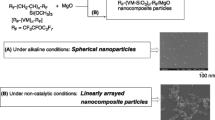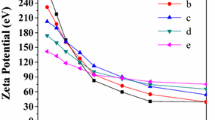Abstract
In this work, we synthesized free-standing disk-shaped gels (FGPEI) from the chemical cross-linking of linear polyethyleneimine (LPEI), and investigated their crystalline features in gel state and templating function in mineralizations of silica and titania. It was found that the FGPEIs with different cross-linkers and different cross-linking degrees showed remarkable crystalline properties in water containing state but became amorphous in the swollen state in methanol. This is reversible by alternating the medium of water and methanol. The crystalline domains in the FGPEI were estimated by XRD as in the ranges of 3.0~11 nm. Immersion of the disk-shaped FGPEIs in tetramethoxysilane (TMOS) solutions spontaneously resulted in the corresponding hybrids SiO2/FGPEIs keeping the same disk shape with silica content of 63%. Calcinating the hybrids could tune them into monolith silica with mesoporous structure consisting of nanoparticle (ca. 20 nm) agglomeration. On the other hand, immersion of the FGPEI in tetraisopropyloxy titanium solution offered hybrid of TiO2/FGPEI but only with ca. 14% content of TiO2. However, calcination of this hybrid at different temperatures could result in monolith titania possessing mesopore and/or macropore structures inside with agglomeration of anatase- and/or rutile-type nanoparticles.

ᅟ










Similar content being viewed by others
References
Osada Y, K Kajiwara (1997) Gel handbook, 4–16
Ahn S-K, Kasi M, Kim S-C, Sharma N, Zhou Y (2008) Stimuli-responsive polymer gels Soft Matter 4:1151–1152
Sangeetha N, Maitra U (2005) Supramolecular gels: functions and uses Chem Soc Rev 34:821–836
Russo R, Malinconico M, Santagata G (2007) Effect of cross-linking with calcium ions on the physical properties of alginate films Biomacromolecules 8:3193–3197
Shi J, Gao Y, Zhang Y, Pan Y, Xu B (2011) Calcium ions to cross-link supramolecular nanofibers to tune the elasticity of hydrogels over orders of magnitude Langmuir 27:14425–14431
Krishnamurthi J, Ono T, Amemori S, Komatsu H, Shinkai S, Sada K (2011) Thiourea-tagged poly(octadecyl acrylate) gels as fluoride and acetate responsive polymer gels through selective complexation Chem Commun 47:1571–1573
Jin S, Liu M, Zhang F, Chen S, Niu A (2006) Synthesis and characterization of pH-sensitivity semi-IPN hydrogel based on hydrogen bond between poly(N-vinylpyrrolidone) and poly(acrylic acid) Polymer 47:1526–1532
Nair K, Breedveld V, Weck M (2008) Complementary hydrogen-bonded thermoreversible polymer networks with tunable properties Macromolecules 41:3429–3438
Goto H, Zhang H, Yashima E (2003) Chiral stimuli-responsive gels: helicity induction in poly(phenylacetylene) gels bearing a carboxyl group with chiral amines J Am Chem Soc 125:2516–2523
Du X, Liu J, Deng J, Yang W (2010) Synthesis and chiral recognition of optically active hydrogels containing helical polymer chains Polym Chem 1:1030–1038
Okazaki Y, Cheng J, Dedovets D, Kemper G, Delville M-H, Durrieu M-C, Ihara H, Takafuji M, Pouget E, Oda R (2014) Chiral colloids: homogeneous suspension of individualized sio2 helical and twisted nanoribbons ACS Nano 8:6863–6872
Chang X, Chen D, Jiao X (2008) Chitosan-based aerogels with high adsorption performance J Phys Chem B 112:7721–7725
Taira M, Furuuchi H, Saitoh S, Sugiyama Y, Sekiyama S, Araki Y, Tabata Y (2005) Bio-sorption of acidic gelatine hydro-gels implanted in the back tissues of Fisher’s rats. J Oral Rehabil 32:382–387
Fei H, Yang C, Bao H, Wang G (2014) Flexible all-solid-state supercapacitors based on graphene/carbon black nanoparticle film electrodes and cross-linked poly(vinyl alcohol)-H2SO4 porous gel electrolytes J Power Sources 266:488–495
Kelkar S, Pandey K, Agarkar S, Saikhedkar N, Tathavadekar M, Agrawal I, Gundloori R, Ogale S (2014) Functionally engineered egg albumen gel for quasi-solid dye sensitized solar cells ACS Sustain Chem Eng 2:2707–2714
Kim D, Park H, Rhim J, Lee Y (2005) Proton conductivity and methanol transport behavior of cross-linked PVA/PAA/silica hybrid membranes Solid State Ionics 176:117–126
Beamish J, Zhu JK, Marchant R (2010) The effects of monoacrylated poly(ethylene glycol) on the properties of poly(ethylene glycol) diacrylate hydrogels used for tissue engineering Biomed Mater Res A 92:441–450
Grover G, Braden R, Christman K (2013) Oxime cross-linked injectable hydrogels for catheter delivery Adv Mater 25:2937–2942
Jan J-S, Chen P-S, Hsieh P-L, Chen B-Y (2012) Silicification of genipin-cross-linked polypeptide hydrogels toward biohybrid materials and mesoporous oxides ACS Appl Mater Interfaces 4:6865–6874
Drisko G, Wang X, Caruso R (2011) Strong silica monoliths with large mesopores prepared using agarose gel templates Langmuir 27:2124–2127
Kobayashi S, Shirasaka H, Suh K-D, Uyama H (1990) Viscosity behaviors and gel properties of linear and branched polyethyleneimines: effects of micro-structures Polym J 22:442–446
Neu M, Sitterberg J, Bakowsky U, Kissel T (2006) Stabilized nanocarriers for plasmids based upon cross-linked poly(ethylene imine) Biomacromolecules 7:3428–3438
Wang G, Yin H, Ng J, Cai L, Li J, Tang B, Liu B (2013) Polyethyleneimine-grafted hyperbranched conjugated polyelectrolytes: synthesis and imaging of gene delivery Polym Chem 4:5297–5304
Kislenko V, Oliynyk L (2002) Complex formation of polyethyleneimine with copper(II), nickel(II), and cobalt(II) ions J Polym Sci A Polym Chem 40:914–922
Maketon W, Zenner C, Ogden K (2008) Removal efficiency and binding mechanisms of copper and copper-edta complexes using polyethyleneimine Environ Sci Technol 42:2124–2129
Yuan J-J, Jin R-H (2005) Fibrous crystalline hydrogels formed from polymers possessing a linear poly(ethyleneimine) backbone Langmuir 21:3136–3145
Chatani Y, Tadokoro H, Saegusa T, Ikeda H (1981) Structural studies of poly(ethylenimine). 1. Structures of two hydrates of poly(ethylenimine): sesquihydrate and dihydrate Macromolecules 14:315–321
Chatani Y, Kobatake T, Tadokoro H, Tanaka R (1982) Structural studies of poly(ethylenimine). 2. Double-stranded helical chains in the anhydrate Macromolecules 15:170–176
Chatani Y, Kobatake T, Tadokoro H (1983) Structural studies of poly(ethylenimine). 3. Structural characterization of anhydrous and hydrous states and crystal structure of the hemihydrate Macromolecules 16:199–204
Jin R-H, Yuan J-J (2005) Synthesis of poly(ethyleneimine)s–silica hybrid particles with complex shapes and hierarchical structures Chem Commun:1399–1401
Yuan J-J, Zhu P-X, Fukazawa N, Jin R-H (2006) Synthesis of nanofiber-based silica networks mediated by organized poly(ethylene imine): structure, properties, and mechanism Adv Funct Mater 16:2205–2212
Jin R-H, Yuan J-J (2005) Simple synthesis of hierarchically structured silicas by poly(ethyleneimine) aggregates pre-organized by media modulation Macromol Chem Phys 206:2160–2170
Jin R-H, Yuan J-J (2007) Hierarchically structured silica from mediation of linear poly(ethyleneimine) incorporated with acidic/basic additives Polym J 39:464–470
Zhu P-X, Fukazawa N, Jin R-H (2007) Polyethyleneimine aggregates regulated by metal cations acting as biomimetic organic reactors for silica architectures Small 3:394–398
Matsukizono H, Zhu P-X, Fukazawa N, Jin R-H (2009) Turbine-like structured silica transcribed simply by pre-structured crystallites of linear poly(ethyleneimine) bounded with metal ions Cryst Eng Comm 11:2695–2700
Kokufuta E, Suzuki H, Yoshida R, Yamada K, Hirata M, Kaneko Y (1998) Role of hydrogen bonding and hydrophobic interaction in the volume collapse of a poly(ethylenimine) gel Langmuir 14:788–795
Yu J, Zhao X, Du J, Chen W (2000) Preparation, microstructure and photocatalytic activity of the porous TiO2 anatase coating by sol-gel processing J Sol-Gel Sci Technol 17:163–171
Auffan M, Pedeutour M, Rose J, Masion A, Ziarelli F, Borschneck D, Chaneac C, Botta C, Chaurand P, Labille J (2010) Structural degradation at the surface of a tio2-based nanomaterial used in cosmetics Environ Sci Technol 44:2689–2694
Joo J, Zhang Q, Lee I, Dahl M, Zaera F, Yin Y (2012) Mesoporous anatase titania hollow nanostructures though silica-protected calcination Adv Funct Mater 22:166–174
Jin R-H, Yuan J-J (2009) Biomimetically controlled formation of nanotextured silica/titania films on arbitrary substrates and their tunable surface function Adv Mater 21:3750–3753
Zhu P-X, Jin R-H (2010) Simple and efficient aqueous process for nanostructured fibrous TiO2 regulated by linear polyethyleneimine aggregates Eur J Inorg Chem 2010:476–482
Acknowledgements
This work was supported in part by the MEXT Supported Program for the Strategic Research Foundation at Private Universities: “Creation of new fusion materials by integration of highly-ordered nano inorganic materials and ultra-precisely controlled organic polymers” (2013-2017), no. S1311032.
Author information
Authors and Affiliations
Corresponding author
Ethics declarations
Conflict of interest
The authors declare that they have no conflict of interest.
Electronic supplementary material
ESM 1
(DOCX 1576 kb).
Rights and permissions
About this article
Cite this article
Soma, D., Jin, RH. Free-standing disk mold crystalline polyethyleneimine gels: physical properties and chemical function in mineralization. Colloid Polym Sci 295, 1585–1594 (2017). https://doi.org/10.1007/s00396-017-4125-6
Received:
Revised:
Accepted:
Published:
Issue Date:
DOI: https://doi.org/10.1007/s00396-017-4125-6




